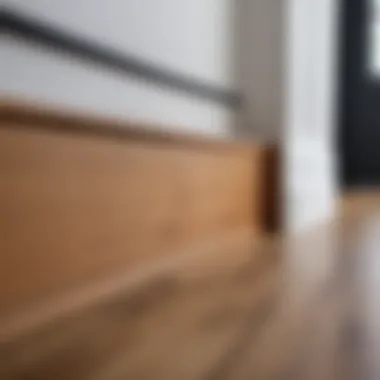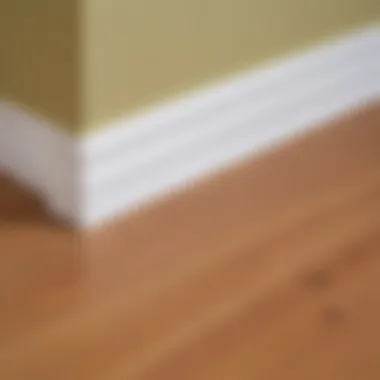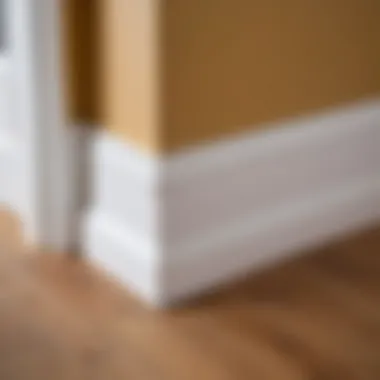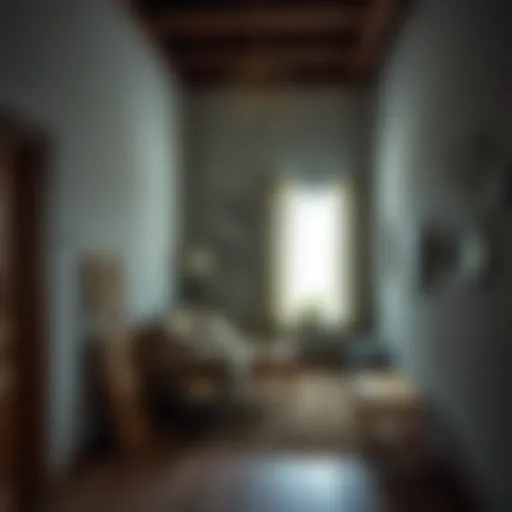Choosing the Right Floor Skirting Board: A Guide


Intro
Selecting the right floor skirting board is a more nuanced task than one might initially assume. It involves considering factors that bridge the visual appeal of a space with the practical requirements of installation and long-term maintenance. The right choice can significantly enhance the overall aesthetic of a room while also serving functional purposes, like protecting walls from scuffs and allowing for easier cleaning.
As we navigate through this guide, we will cover essential topics that equip readers with the understanding necessary to make informed choices. By addressing various materials, styles, and application techniques, we aim to provide a thorough foundation for any home improvement project involving skirting boards. Whether you are a seasoned DIY enthusiast or a newcomer to the world of home renovation, this comprehensive approach is tailored to illuminate the path toward selecting the ideal skirting boards for your specific needs.
Проектирование и планирование
In any home improvement project, effective planning and design are crucial. Choosing skirting boards is no exception. A proper approach involves understanding your project goals and establishing a structured plan to achieve them.
Как выбрать проект для DIY
First, determine the overall design aesthetic you aim to achieve in your space. Is it modern, traditional, or perhaps eclectic? Drawing inspiration from various sources, such as interior design magazines or even platforms like Reddit, can spark ideas. This will influence your choice of skirting boards. Consider the height, thickness, and style of the skirting in the context of your walls and flooring.
Оценка времени и ресурсов
Next, assess the time and resources required for your project. This includes the acquisition of necessary tools and materials, as well as the estimated time for installation. Knowing what to expect prevents surprises and ensures a smoother process. It’s prudent to sketch out a timeline, including stages for preparation, installation, and finishing touches. This structured planning helps mitigate potential disruptions.
Выбор материалов
The choice of materials can significantly influence both the look and function of skirting boards. Understanding the pros and cons of various materials is essential for making the right decision for your specific situation.
Типы материалов для различных проектов
There are several material options available:
- MDF (Medium Density Fiberboard): Affordable and easy to paint, making it a popular choice for many homeowners.
- Solid Wood: Offers a classic appearance and durability, but comes at a higher cost and requires ongoing maintenance.
- PVC (Polyvinyl Chloride): Water-resistant and easy to clean, but may not provide the same aesthetic appeal as wood.
- Metal: Provides a contemporary look and is highly durable, suitable for industrial-style homes.
Советы по покупке и экономии
When purchasing materials, consider comparing prices across various suppliers. Look for discounts or bulk purchase options to maximize savings. Websites like Facebook Marketplace or local classifieds may also have affordable second-hand skirting boards. Always prioritize quality over price; a lasting choice provides better long-term value.
"Quality skirting boards can elevate a room’s design significantly while protecting walls from wear. Prioritize materials that suit your functional needs and design vision."
In summary, choosing the right floor skirting board is a multifaceted decision. With thoughtful planning, material selection, and an understanding of project requirements, you can achieve a harmonious balance between form and function in your home.
Understanding Skirting Boards
Skirting boards serve a vital role in home design as they are fundamental in bridging gaps between the wall and the floor. Their main aim is to protect the wall from furniture damage, scuffs, and everyday wear. Understanding skirting boards involves recognizing their function, significance in interior decor, and historical evolution. This knowledge is essential for making informed choices when selecting the right design and material for your project.
The choice of skirting board can enhance or detract from the overall aesthetic of a room. It has the power to unify styles, complement colors, and even influence the perception of space. By examining the components and implications of skirting boards, readers can appreciate how these details contribute to the functionality and visual appeal of a home.
Moreover, details such as height, material, and design style are crucial for various settings and uses. Keeping a balance between aesthetics and practical function will ultimately aid homeowners and professionals in achieving their desired results.
Definition and Purpose
Skirting boards, often referred to as baseboards, are strips of material installed at the lower part of interior walls. Their primary purpose is to provide a covering for the joint between the wall surface and the floor. Furthermore, they protect walls from being damaged by foot traffic, furniture, and cleaning tools.
In addition to their protective function, skirting boards fulfill an aesthetic purpose. They offer a finishing touch that can enhance the beauty of a room's design. Various styles exist, from contemporary minimalist designs to more ornate traditional models, allowing for great personalization in home decor.
Historical Context
The use of skirting boards can be traced back to ancient times when they served both functional and decorative purposes. Initially, they were created to protect walls from moisture and damage, especially in homes with earthen floors. Over the centuries, skirting boards evolved in style and composition, reflecting the architectural trends of different eras.
In the 18th and 19th centuries, as homes became more sophisticated, skirting boards gained prominence as a decorative element in interior design. They were often elaborately carved and painted to match the style of the home. The Victorian era, for example, saw the emergence of more detailed skirting designs that expressed the wealth and taste of homeowners.
Today, while the protective role is still essential, the emphasis on design continues to grow. Modern technology has introduced new materials and styles that cater to various tastes and preferences, cementing the relevance of skirting boards in contemporary home renovations.
Types of Floor Skirting Boards
Understanding the types of floor skirting boards is crucial for making an informed choice. Skirting boards serve not only a practical purpose but also contribute significantly to the overall look of a room. Each material type offers distinct advantages and drawbacks, influencing both functionality and aesthetic appeal. This section will detail different skirting board types, emphasizing their properties and applications, helping readers to select the most suitable option for their needs.


Wooden Skirting Boards
Wooden skirting boards are a traditional choice, known for their timeless appeal. They offer a warm and natural look, making them popular among homeowners and designers alike.
Solid Wood
Solid wood skirting boards are crafted from a single piece of timber, which makes them durable and robust. Their strength is a key characteristic, contributing to a long lifespan. Solid wood can withstand wear and tear better than many other materials, making it a beneficial choice for high-traffic areas.
A unique feature of solid wood is its ability to be sanded and refinished, allowing for customization and repair over time. This adaptability is advantageous, especially for homeowners who wish to maintain a fresh look without needing replacement. However, solid wood can be sensitive to humidity, which might lead to warping or cracking in certain conditions, presenting a drawback in humid climates.
MDF
Medium Density Fiberboard (MDF) skirting boards are produced from wood fibers and resin, providing a smooth and even surface. A significant characteristic of MDF is its affordability compared to solid wood, making it an attractive option for budget-conscious consumers.
MDF skirting boards can be easily painted, allowing for a wide range of colors and finishes. This versatility is perfect for those looking to enhance their interior decor without significant investment. However, it is worth noting that MDF is less durable than solid wood. While it can mimic the appearance of wood, it is more susceptible to damage from moisture and can swell if exposed to water.
PVC Skirting Boards
PVC skirting boards are gaining popularity due to their moisture resistance and ease of maintenance. Being made from plastic, these boards do not warp, rot, or swell, making them ideal for areas with high humidity, such as bathrooms and kitchens.
These skirting boards come in various colors and finishes, offering flexibility in design. They are also lightweight, making installation an easier proposition. However, the primary downside is that some may find PVC less visually appealing compared to natural wood, which may not suit all interior designs.
Metal Skirting Boards
Metal skirting boards, such as aluminum or stainless steel, represent a modern choice that combines durability with a sleek aesthetic. Their strength and resistance to wear make them suitable for commercial spaces as well as contemporary residential design.
The shiny finish of metal skirting boards can enhance a room's lighting and create a modern feel. However, installation can be more complex compared to wooden or PVC options, and the cost might be higher, which can deter some users.
Custom-Made Options
For those looking for something truly unique, custom-made skirting boards allow for complete personalization. Homeowners can choose the material, design, and dimensions, ensuring a perfect fit with their interior.
Custom options can embody specific styles or themes, providing an artistic touch that pre-made boards may not offer. The downside lies in the cost, as custom solutions tend to be more expensive and require longer lead times for production and installation.
Custom-made skirting boards provide an opportunity to express individuality while maintaining functionality and aesthetic coherence in interior design.
Factors Influencing Choice of Skirting Board
Choosing the right skirting board is not merely about aesthetics; it involves various practical considerations that align with the specifics of each room and the intended function of the space. This section delves into the critical factors that influence the choice of skirting board, helping you make informed decisions that reflect both practicality and design aspirations.
Room Type and Functionality
The features of a room significantly dictate the type of skirting board suitable for installation. For instance, in high-traffic areas, a more durable skirting board material is essential to withstand impacts and scrapes. Conversely, in spaces like bedrooms, where the environment is generally calmer, a more delicate design or finish might be favored. The functionality of the room also plays a role. Skirting boards in kitchens or bathrooms may need to be moisture-resistant, while living areas can focus more on style and design without the need for specialized materials. Therefore, understanding the purpose of each room is crucial when selecting skirting boards that will not only complement the decor but also meet the practical demands of the space.
Aesthetic Considerations
Color Coordination
Color coordination is an important aspect of interior design that greatly impacts the ambiance of a room. Choosing skirting boards that align well with your walls and overall decor creates a cohesive look. The key characteristic of effective color coordination is the ability to blend or contrast colors in a way that enhances the existing color palette of the room. Neutral colors offer flexibility and will often work well in any setting, making them a popular choice. On the other hand, skirting boards that match or complement the wall color can create a seamless flow. The unique feature of color coordination lies in its ability to visually expand spaces or draw attention to particular design elements, though improper choices can lead to a disjointed feel in the room.
Style Consistency
Style consistency involves maintaining a uniform design language throughout different features of a space. This entails ensuring that the skirting board design complements the overall style of the room, whether that be modern, traditional, or eclectic. The key characteristic of style consistency is its role in creating harmony within the home's interior design. It is beneficial because it aligns all elements of the room, providing visual comfort and clarity. A unique feature of this approach is that it can either emphasize a focal point by contrasting styles or enhance the overall sophistication of a uniform design. However, so emphasizing one style may risk making the skirting boards less adaptable to changing trends or personal tastes.
Durability and Maintenance
Durability and maintenance considerations play a pivotal role in deciding which skirting boards to install. Generally, the type of material selected determines the longevity of the skirting board. For instance, wooden skirting boards may offer an aesthetic appeal but require regular maintenance to retain their quality. On the other hand, materials like PVC can promise high durability and minimal upkeep. The functional demands of the room also dictate these choices. High-moisture areas such as bathrooms demand materials that resist warping or discoloration. Furthermore, durability influences cost-effectiveness in the long run. It is essential to weigh these factors carefully. A cost-effective choice that needs frequent replacement can ultimately become more expensive than investing in higher-quality materials from the start.
In summary, the factors influencing the choice of skirting board encompass both practical needs and aesthetic desires. Taking into account the room type, color coordination, style consistency, as well as durability and maintenance ensures that the chosen skirting board serves its purpose effectively while enriching the overall appeal of the space.
Practical Aspects of Installation


The installation of floor skirting boards is a critical aspect often overlooked by both DIY enthusiasts and professionals. Proper installation not only enhances the aesthetic appeal of a room but also serves practical functions. Skirting boards can protect walls from damage caused by furniture, cleaning activities, and foot traffic. They also cover the gap between the wall and floor, giving a finished look and preventing dust accumulation. Therefore, understanding practical aspects of installation is essential to ensure that the skirting boards are functional, durable, and visually appealing.
Measurement and Planning
Before any installation takes place, measurement and planning are essential. Accurate measurement of walls is crucial in determining how much material is needed. This helps in avoiding both underbuying and overbuying materials. Measure the height of the skirting board to ensure it complements the room's proportions. Planning includes selecting the right type of skirting board for each room, taking into consideration factors such as moisture levels and foot traffic. Furthermore, one should account for corners and angles in rooms to avoid gaps.
Installation Techniques
Adhesive Methods
Adhesive methods are a popular choice for installing skirting boards. The use of adhesives simplifies the process, as it does not require drilling into walls, which can limit damage to surfaces. This method is particularly suitable for lightweight boards. The key characteristics of adhesive methods include ease of application and quick installation time. However, one must be cautious about choosing the right adhesive to ensure that it bonds adequately with the skirting board and the wall surface. The unique feature of adhesive methods lies in the reduced need for tools, making it a favorable option for DIY projects.
The advantages of using adhesive methods include:
- Minimal wall damage during installation.
- Faster installation time.
- Less equipment requirement.
However, some disadvantages exist. For example, if not properly applied, the bond may weaken over time, leading to potential displacements.
Screw Fixing
Screw fixing is another widely used technique for skirting board installation. This method involves using screws to secure the boards to the walls, which provides a strong and durable bond. The key characteristic of screw fixing is its reliability and longevity, making it a preferred choice, especially in high-traffic areas where durability is essential.
The unique feature of screw fixing is that it allows for easy removal and replacement of skirting boards, an important factor for renovations or repairs.
Advantages of screw fixing include:
- Enhanced durability and stability.
- Ease of future removal for repairs.
- Greater support for heavy materials.
On the downside, screw fixing requires more tools and slightly more time to install, as drilling into the wall is necessary.
Tools Required for Installation
Using the right tools can significantly influence the efficiency of skirting board installation. The following tools are recommended:
- Measuring Tape: For accurate measurements of length and height.
- Saw: A miter saw is ideal for cutting corners at specific angles.
- Drill/Driver: Essential for screw fixing.
- Adhesive Applicator: If using adhesive methods, having a proper applicator helps in even distribution.
- Level: Ensures installation is straight and aligned.
By being equipped with the proper tools and knowledge of installation techniques, achieving a professional finish on floor skirting boards becomes a manageable task.
Skirting Board Finishes
Skirting board finishes significantly affect both the aesthetic appeal and functionality of a room. The finish chosen can set the entire mood of the space, tying together design elements while providing necessary protection for the walls and skirting itself. Selecting the right finish requires careful thought about the room’s overall character, color schemes, and the materials involved. Additionally, finishes can offer varying levels of durability, ease of maintenance, and aesthetic attraction, making them a crucial aspect of any home improvement project.
Painted Finishes
Painted finishes are popular due to their versatility and ease of application. This type of finish allows for a broad range of colors, enabling seamless coordination with existing decor. Whether you prefer a glossy sheen or a matte appearance, painted finishes can cater to different styles, from modern to traditional. One of the key benefits is the ability to refresh the look of a room without extensive renovations.
From a practical viewpoint, painted finishes protect the skirting boards from wear and tear. They provide a barrier against scratches, moisture, and dirt, which can be particularly beneficial in high-traffic areas. Maintenance tends to be straightforward; occasional touch-ups are often all that is required to keep them looking new. Choosing the right type of paint—ideally one that is durable, stain-resistant, and easy to clean—will enhance the longevity and functionality of the skirting board.
Natural Wood Finishes
Natural wood finishes celebrate the inherent beauty of wood grain and texture. This option is often sought after for its warmth and authenticity, appealing to those who wish to maintain a classic or rustic feel in their homes. Finishing wood can involve oiling, staining, or sealing, all of which highlight the unique characteristics of the grain.
Some advantages of natural wood finishes include their eco-friendliness and the chemical-free approach often associated with oil finishes. Additionally, they are relatively easy to maintain. Natural wood skirting boards need periodic oiling or sealing to preserve their protective qualities, but this process typically enhances the aesthetic as well. It is essential to consider the type of wood used, as some may require more maintenance than others.
Veneered Options
Veneered skirting boards offer an economical alternative to solid wood. They consist of a thin layer of real wood glued over a core of another material, often MDF or plywood. This provides the appearance of solid wood at a fraction of the cost, making it a wise choice for budget-conscious designers and homeowners.
One of their significant benefits is the ability to select from various wood species, allowing greater flexibility in matching the skirting board to existing furniture or cabinetry. Veneered boards can also provide a level of durability, although they must be treated with care to avoid damage to the veneer layer. In terms of maintenance, cleaning is usually straightforward, and refinishing may be done if the veneer is adequately thick.
In summary, understanding the types of finishes available is essential in making an informed choice for skirting boards. Each finish offers distinct benefits and considerations that can shape the practicality and aesthetic quality of your interior design.


Environmental Considerations
The selection of floor skirting boards involves more than mere aesthetics and functionality. The impact of these choices on the environment is increasingly significant. Skirting boards are not only a decorative feature but also play a role in the overall health of both homes and the planet. Understanding environmental considerations can guide individuals in selecting products that are sustainable and beneficial for indoor air quality.
Sustainability of Materials
When contemplating skirting boards, the sustainability of materials is a crucial factor. The environmental footprint is influenced by the resources used for manufacturing. Opting for materials like reclaimed wood or bamboo can reduce deforestation and the carbon footprint associated with traditional timber.
- Reclaimed Wood: This material is sourced from old buildings or furniture, minimizing waste and demand for new timber. It adds character and is often more durable due to its age.
- Bamboo: This fast-growing grass is a renewable resource. Its harvesting does not involve cutting down trees, making it an eco-friendly choice. Bamboo has strong resilience and can be used in various styles.
- MDF and Other Composites: Medium-density fiberboard is constructed from wood fibers, which can include recycled materials. It is important to ensure that these products come from responsibly managed forests to maintain sustainability standards.
In this context, businesses that adhere to sustainable practices are often certified. Look for labels and certifications that indicate responsible sourcing, such as PEFC or FSC. By choosing sustainable materials, consumers take a step towards reducing environmental impact while enhancing their interior spaces.
Impact on Indoor Air Quality
Indoor air quality is an essential aspect influenced by the types of skirting boards chosen. Many traditional materials used in skirting boards can off-gas volatile organic compounds (VOCs). These emissions can pose health risks and contribute to indoor pollution.
- Low-VOC Options: Selecting paints and adhesives that are low in VOCs can improve indoor air quality significantly. It is advisable to verify product labels to ensure they meet lower emission standards.
- Natural Finishes: Using materials finished with natural oils and waxes, rather than synthetic alternatives, can reduce harmful emissions. Products like linseed oil or beeswax provide protective finishes while remaining non-toxic.
- Ventilation Considerations: Proper installation can minimize dust accumulation and potential mold growth. Adequate ventilation during and after installation also helps in reducing indoor pollutants.
Cost Considerations
Understanding the costs associated with floor skirting boards is crucial for making informed decisions. Costs impact not only the initial budget but also the long-term value of any home improvement project. Balancing quality and affordability can significantly influence the final outcome of a renovation or design work.
Material Cost Analysis
When examining skirting boards, the variety of materials available comes with differing price points. Wooden skirting boards, especially solid wood options, tend to be more expensive than alternatives like MDF or PVC. Solid wood offers a classic aesthetic but is often regarded as a premium choice due to its durability and appearance.
On the other hand, MDF is a popular option among DIY enthusiasts and professionals alike for its more affordable pricing and versatility. It can be painted or finished to resemble pricier wood types. PVC skirting boards, while cheaper and resistant to moisture, may not have the same visual appeal.
Ultimately, the choice of material will heavily dictate the overall budget. It is recommended to consider factors such as intended use, room conditions, and the desired finish when evaluating material costs.
Installation Costs
Installation costs can vary based on several factors, including location, worker skill level, and the complexity of the job. Hiring a professional installer generally increases costs but can guarantee quality workmanship. For individuals opting to install skirting boards themselves, this might save money, but it is essential to be aware of the necessary tools and skills required.
Some installation methods, like adhesive fixing, may save time and effort compared to screw fixing. However, materials like adhesive or screws also contribute to the overall installation cost, so it is crucial to calculate these expenses beforehand. DIY enthusiasts should also budget for tools, if they do not already own them.
Long-Term Value Assessment
Evaluating the long-term value of skirting boards involves considering not only the material cost and installation costs but also potential repairs, maintenance, and their lifespan. High-quality wooden options might require more upfront investment but tend to last longer and could enhance property value over time.
In contrast, cheaper materials may lead to more frequent replacements or repairs. For instance, a PVC skirting board may be more cost-effective initially, but its longevity is often lower, meaning that it may need replacement sooner than other materials.
In the end, the focus should be on how well the selected skirting boards will maintain their appearance and function over the years. Making a choice based solely on initial prices may lead to greater overall costs if subsequent repairs or replacements are needed later.
Investing in quality skirting boards can enhance both the aesthetic and financial value of a property.
By analyzing these cost considerations, individuals can make better decisions suited to their budgets and long-term renovation goals.
End
In any home improvement journey, selecting the right skirting board is a crucial step. The conclusion of this guide synthesizes the knowledge gained throughout the article. The selection of skirting boards affects aesthetic harmony, durability, and functionality of spaces. Each aspect discussed, from material choices to installation techniques, plays a pivotal role in the decision-making process.
Recap of Key Factors
When considering skirting boards, several key factors should be borne in mind:
- Material Type: The choice between wooden, PVC, metal, or custom-made options can dramatically change the look and feel of the room.
- Aesthetic Appeal: Ensuring color and style coordination with the rest of the interior design is important for a cohesive appearance.
- Durability: Selecting a material that withstands wear and tear is essential. Maintenance requirements also vary by material, impacting long-term satisfaction.
- Installation: Understanding the methods for installing skirting boards ensures they not only fit well but are also functional in their placement.
- Budget Considerations: Costs will vary wildly based on materials and installation choices, making it vital to assess overall budget constraints before finalizing a decision.
Final Thoughts on Skirting Board Selection
The process of choosing skirting boards is more than just a selection of materials. It involves thoughtful consideration of the overall design, function, and practical application within a space. High-quality skirting boards enhance the separation between walls and floors while providing a finishing touch that can elevate the entire room.
Ultimately, investing time into understanding the nuances of each option leads to a more informed selection. Whether you are a homeowner, interior designer, or builder, the right skirting boards can create a sense of completeness and attention to detail that defines a well-designed space.
"Choosing the right skirting board is akin to adding the final stroke on a canvas: it defines the overall character of your space."
Through careful consideration of the factors discussed, one can achieve a harmonious interior that balances aesthetic beauty with practical performance.







